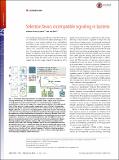Selection favors incompatible signaling in bacteria
Author(s)
Perez Escudero, Alfonso; Gore, Jeff
DownloadPerez-Escudero-2016-Selection favors inc.pdf (683.9Kb)
PUBLISHER_POLICY
Publisher Policy
Article is made available in accordance with the publisher's policy and may be subject to US copyright law. Please refer to the publisher's site for terms of use.
Terms of use
Metadata
Show full item recordAbstract
A cooperative group can achieve more than the sum of its members. Evolution has taken advantage of this principle in most natural systems, from multicellular individuals to ant colonies. To do so, it has provided the members of cooperative groups with communication tools, which are critical for effective cooperation. For example, some ants form bridges with their bodies to help their nest-mates cross a gap. But this admirable behavior only makes sense when many ants mass along the same route; a lone scout that stayed put across a gap instead of wandering off in search for food would do a disservice to the colony. Similarly, many bacteria cooperate in ways that only make sense in large groups, for example secreting a sticky goo to keep bacteria together forming a biofilm, or a slippery one to help movement. To prevent wasting resources on these public goods when bacterial density is too low to have an advantage from them, many species measure local bacterial density using a mechanism called quorum sensing, and produce the public good only when numbers are high enough to make it count. This function of quorum sensing seems straightforward, but one piece of information does not quite make sense: in natural populations, different individuals have different—and incompatible—quorum-sensing machineries. If the bacteria are trying to coordinate with their neighbors, why do they use a different signaling system? In PNAS, Pollak et al. demonstrate an elegant answer to this question: a rare mutant with incompatible quorum-sensing machinery initially exploits the wild-type, but is able to cooperate with its own kind when common in the population.
Date issued
2016-02Department
Massachusetts Institute of Technology. Department of PhysicsJournal
Proceedings of the National Academy of Sciences
Publisher
National Academy of Sciences (U.S.)
Citation
Pérez-Escudero, Alfonso, and Jeff Gore. “Selection Favors Incompatible Signaling in Bacteria.” Proceedings of the National Academy of Sciences 113.8 (2016): 1968–1970. © 2016 National Academy of Sciences.
Version: Final published version
ISSN
0027-8424
1091-6490